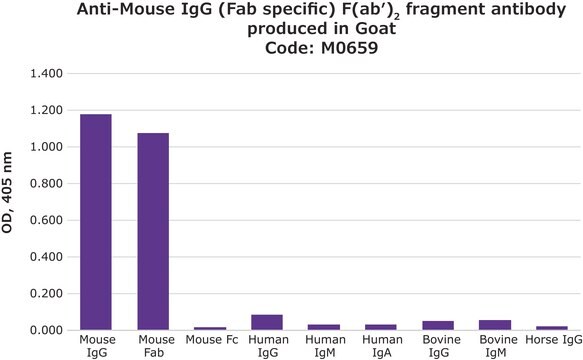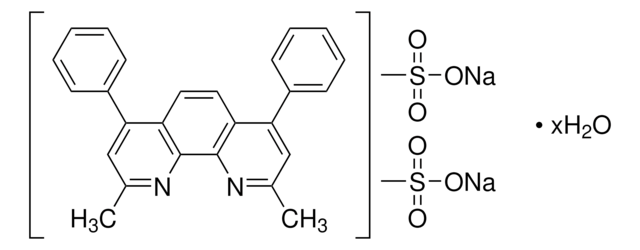AQ303F
Goat Anti-Mouse IgG Antibody, F(ab′)2, FITC conjugate
1 mg/mL, Chemicon®
Synonym(s):
Goat anti-Mouse IgG FITC
About This Item
Recommended Products
biological source
goat
Quality Level
conjugate
FITC conjugate
antibody form
F(ab′)2 fragment of affinity isolated antibody
antibody product type
secondary antibodies
clone
polyclonal
species reactivity
mouse
manufacturer/tradename
Chemicon®
concentration
1 mg/mL
technique(s)
immunofluorescence: suitable
shipped in
wet ice
target post-translational modification
unmodified
General description
PURIFICATION: The goat-lgG was purified by affinity chromatography and absorbed to remove cross-reactivity to human immunoglobulins.
Specificity
Application
Immunocytochemistry: 1:200-1:500 (Coligan et al. 1997; Harlow & Lane 1988; Bullock & Petrusz 1982; Javois 1994)
Flow cytometery: 1 μg per 1 x 10E6 cells (Coligan et al. 1997; Harlow & Lane 1988; Javois 1994) FITC absorption peak is 488-492nm, its emission peak is 520nm.
Optimal working dilutions must be determined by the end user.
Secondary & Control Antibodies
Fragment Specific Secondary Antibodies
Physical form
Storage and Stability
Legal Information
Disclaimer
Not finding the right product?
Try our Product Selector Tool.
Storage Class Code
12 - Non Combustible Liquids
WGK
WGK 2
Flash Point(F)
Not applicable
Flash Point(C)
Not applicable
Certificates of Analysis (COA)
Search for Certificates of Analysis (COA) by entering the products Lot/Batch Number. Lot and Batch Numbers can be found on a product’s label following the words ‘Lot’ or ‘Batch’.
Already Own This Product?
Find documentation for the products that you have recently purchased in the Document Library.
Our team of scientists has experience in all areas of research including Life Science, Material Science, Chemical Synthesis, Chromatography, Analytical and many others.
Contact Technical Service







